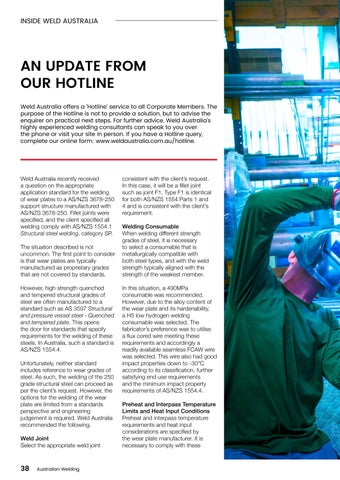INSIDE WELD AUSTRALIA
AN UPDATE FROM OUR HOTLINE Weld Australia offers a ‘Hotline’ service to all Corporate Members. The purpose of the Hotline is not to provide a solution, but to advise the enquirer on practical next steps. For further advice, Weld Australia’s highly experienced welding consultants can speak to you over the phone or visit your site in person. If you have a Hotline query, complete our online form: www.weldaustralia.com.au/hotline.
Weld Australia recently received a question on the appropriate application standard for the welding of wear plates to a AS/NZS 3678-250 support structure manufactured with AS/NZS 3678-250. Fillet joints were specified, and the client specified all welding comply with AS/NZS 1554.1 Structural steel welding, category SP. The situation described is not uncommon. The first point to consider is that wear plates are typically manufactured as proprietary grades that are not covered by standards. However, high strength quenched and tempered structural grades of steel are often manufactured to a standard such as AS 3597 Structural and pressure vessel steel - Quenched and tempered plate. This opens the door for standards that specify requirements for the welding of these steels. In Australia, such a standard is AS/NZS 1554.4. Unfortunately, neither standard includes reference to wear grades of steel. As such, the welding of the 250 grade structural steel can proceed as per the client’s request. However, the options for the welding of the wear plate are limited from a standards perspective and engineering judgement is required. Weld Australia recommended the following. Weld Joint Select the appropriate weld joint
38
Australian Welding
consistent with the client’s request. In this case, it will be a fillet joint such as joint F1. Type F1 is identical for both AS/NZS 1554 Parts 1 and 4 and is consistent with the client’s requirement. Welding Consumable When welding different strength grades of steel, it is necessary to select a consumable that is metallurgically compatible with both steel types, and with the weld strength typically aligned with the strength of the weakest member. In this situation, a 490MPa consumable was recommended. However, due to the alloy content of the wear plate and its hardenability, a H5 low hydrogen welding consumable was selected. The fabricator’s preference was to utilise a flux cored wire meeting these requirements and accordingly a readily available seamless FCAW wire was selected. This wire also had good impact properties down to -30°C according to its classification, further satisfying end use requirements and the minimum impact property requirements of AS/NZS 1554.4. Preheat and Interpass Temperature Limits and Heat Input Conditions Preheat and interpass temperature requirements and heat input considerations are specified by the wear plate manufacturer. It is necessary to comply with these












